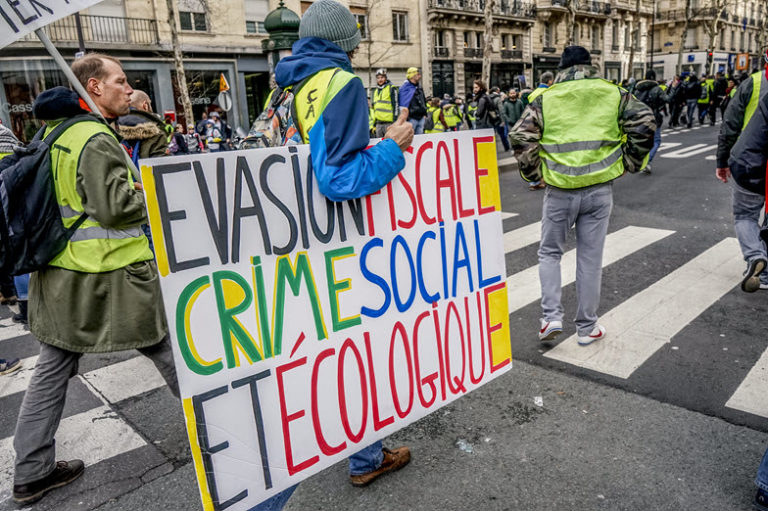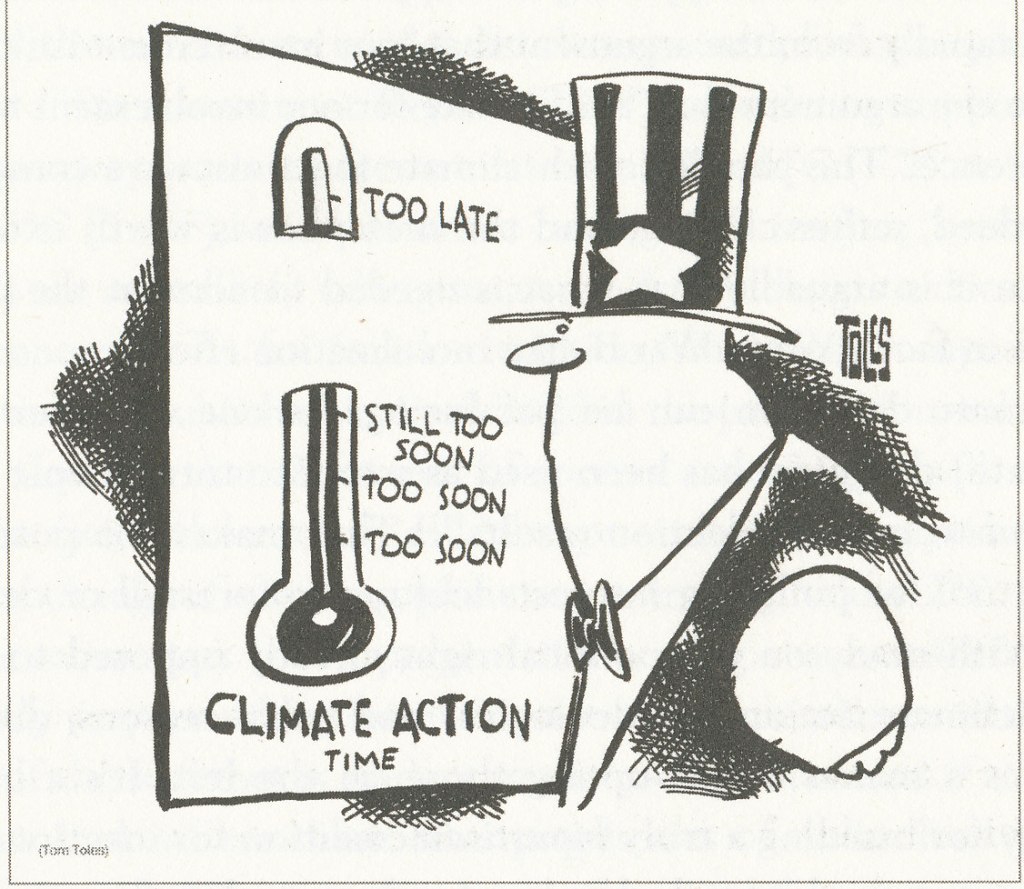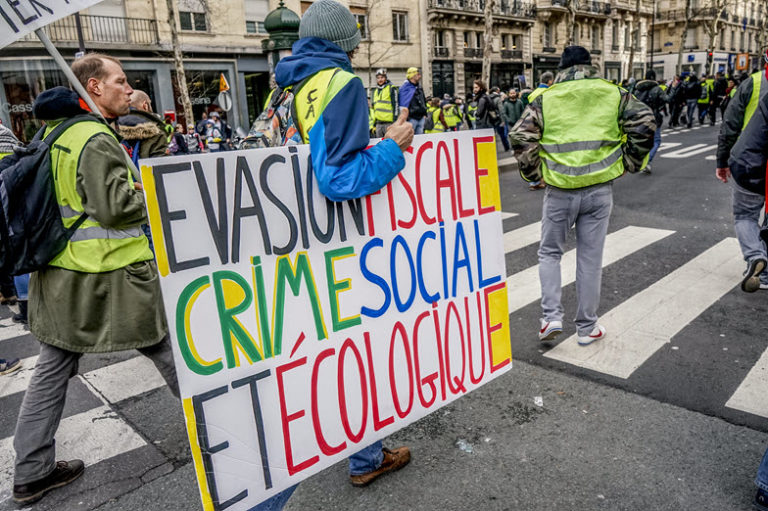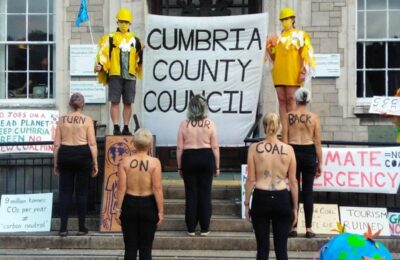This substantial review of The New Climate War: the fight to take back our planet, by Michael E. Mann (London: Scribe Publications, 2021) by Simon Pirani first appeared at People & Nature.
Fossil fuel companies, right-wing plutocrats and oil-funded governments “can no longer insist, with a straight face, that nothing is happening”, Michael Mann writes. Outright denial of the physical evidence of climate change is no longer credible.
So they have shifted to a softer form of denialism while keeping the oil flowing and fossil fuels burning, engaging in a multipronged offensive based on deception, distraction and delay. This is the new climate war, and the planet is losing (page 3).
The enemy’s weapons in this new war, Mann argues, include greenwash, illusory technofixes such as capturing carbon from the air, and deflecting attention on to individual behaviour instead of what companies do.

Mann, a climatologist at the Earth and Environmental Systems Institute at Penn State University in the US, was in the old climate war, too. He was lead author of a 1999 article featuring the now-famous “hockey stick” graph, showing that temperatures ramped sharply upwards in the late 20th century, out of the range of the previous 1000 years.
In 2001, after the graph appeared in the Third Assessment Report by the Intergovernmental Panel on Climate Change (IPCC), climate science deniers orchestrated a public hate campaign against its authors, and others who worked with them.
The witch-hunt culminated in socalled “climategate”, in 2009, when – a few weeks before the Copenhagen climate summit – thousands of emails between scientists were hacked, and parts published out of context, to make it appear that they manipulated evidence to provide proof of global warming where there was none.
Some victims of the frenzy never really recovered. (See this retrospective and this interview.) Mann, for whatever psychological reasons, came out all guns blazing. In his earlier book, The Hockey Stick and the Climate Wars (2012), he explained how the wall between science and politics fell down, for him.
When Mann started out as a scientist, he had “wanted nothing more than to be left alone analysing data, constructing and running theoretical climate models, and pursuing curiosity-driven science. […] Taking anything even remotely resembling a position regarding climate change policy was, to me, anathema. Doing so, I felt, would compromise the authority of my science.” But then came the “hockey stick”, and:
Everything I have experienced since then has gradually convinced me that my former viewpoint was misguided. I became a public figure involuntarily […] but I have come to embrace, rather than eschew, that role. (The Hockey Stick, page 253).
It is this new Michael Mann – a communicator and chatty, obsessive tweeter, a combative “progressive” in US political terms – who has written The New Climate War.
He is hugely convincing on “non-solution solutions” such as geoengineering. He skewers the “soothing words and terms – ‘bridge fuels’, ‘clean coal’, ‘adaptation’, ‘resilience’ – that convey the illusion of action but, in context, are empty promises” (page 147).
Mann derides the techno-fixers’ focus on direct air capture, and questions climate scientists (David Keith of Harvard University, a signatory of the Ecomodernist Manifesto, and Ken Caldeira, formerly of Stanford University), who have accepted millions of dollars in geoengineering research funding. Mann feels that “their attitude towards real-world geoengineering potentially crosses the line from dispassionate inquiry to advocacy” – about which they are defensive and not “up front” (page 163).
Another of Mann’s targets is the public focus on individuals’ consumption as a socalled cause of climate change, and the “finger-pointing, behaviour-shaming, virtue-signalling and purity tests” that goes with it. The concept of a “personal carbon footprint” was promoted by BP, the oil company, he points out (page 63).
Opponents of political action on climate often target public figures who support action with charges of “hypocrisy” about their own behaviour – “a brilliant strategy, because it associates concern about climate with social elites” (page 82).
Mann’s conclusion is that, while “we should all engage in climate-friendly individual actions”, we should not think that by doing so “your duty is done” (page 97). “We can not solve this problem without deep systemic change, and that necessitates government action.”
By “systemic change”, Mann means reshaping capitalism, primarily with carbon taxes. He writes:
Climate action requires a fundamental transition in our global economy and massive new infrastructure, but there is no reason to think we can’t accomplish it – and accomplish it rapidly – with the right market incentives. Those incentives […] must involve supply-side and demand-side measures (page 120).
For Mann, the most important such measure is some sort of tax, or price, attached to each unit of carbon emitted into the atmosphere. He opposes state intervention in the form of the US Green New Deal, which he fears will alienate Republican politicians who favour climate action. (He also makes that argument in a review of Naomi Klein’s recent book.)
Mann acknowledges the fear that “a price on carbon amounts to a regressive tax that selectively hurts low-income workers” (page 108) – but insists it need not be that way. Whether a carbon tax is progressive (i.e. weighted against income inequality) or regressive depends on how it is designed, he points out. The fee-and-dividend method – favoured by the Tax Justice Network and other campaigners – can actually return all the income raised from a carbon tax back to the whole population, or to the lowest-income part of the population.
The trouble is that, in the real world, few governments show signs of moving in that direction. Mann points to the Canadian carbon tax scheme, which is better than most. But most carbon taxes and prices are not progressive, and most of them are not effective in nixing fossil fuels either.
A report from the High Level Commission on Carbon Prices recently claimed that carbon prices of $40-$80/tonne would be needed, by 2020, to pursue the 1.5 degree target; in that year, World Bank researchers found that only about 5% of carbon prices were at that level, and that only one-fifth of global emissions are covered by these taxes, anyway.
Carbon taxes continue to be dwarfed by subsidies to fossil fuel production and consumption. Mann writes that fossil fuel subsidies are “an unfair advantage over climate-friendly renewable energy” (page 99) – but he doesn’t elaborate, focusing instead on arguments in favour of state support for renewable energy (from page 123). He doesn’t probe the systemic character of support for fossil fuels.
(The most recent research by the Organisation for Economic Cooperation and Development (OECD) showed that in 2019 those subsidies totalled $178 billion: the spike upwards in that year was mainly due to OECD member states (i.e. rich countries) giving direct and indirect support to fossil fuel production – that is, handing out money to oil companies.)
My point is not that taxes on carbon are wrong in principle. Here in the UK, for example, scrapping outrageous tax breaks on oil and gas production (also defined as subsidies) could raise hundreds of millions of pounds. But carbon taxes will always have a social impact, too. The more effectively they hit corporations, the fiercer will be the resistance from those corporations. When aimed at populations, they will probably resist, too. This is never going to be disentangled from the way power is exerted in society and (dare I say it) class struggle.
The further Mann goes in to the social implications of the transition away from fossil fuels, the greater the problems I had with his arguments. He rightly derides claims by Bjorn Lomborg and other climate science deniers that fossil fuel production is the key to tackling energy poverty (page 133) – but his description of energy poverty as a “contrived concept” (page 132) or a “myth” (page 134) is deeply disappointing.
Energy poverty is not only a reality facing hundreds of millions of people (770 million who still have no electricity access, according to current statistics), but also a concept used for many years by researchers and social justice campaigners trying to understand and tackle that reality.
Because poverty, the social relations that produce it, and climate change, are so closely bound together, it’s ideas of social change that try artificially to separate them that are mythical, in my view. It is society as a whole, not governments, that will find ways to tackle climate change – and no such social mobilisation is conceivable separated from movements that combat the endless attempts by the rich to keep the poor in poverty.
Take the Yellow Vests revolt in France. Mann writes: “although most of the protesters actually supported action on climate, they opposed a proposed fuel tax, which they were led to believe would be financed by the working class and poor to the benefit of multinational corporations”. Moreover, “Russian trolls helped incite protests and rioting […] using messaging that played upon class conflict” (page 106).

While there’s no doubt about the Kremlin’s readiness to troll European politicians, this view suggests that the Yellow Vests were duped. Not at all. They were furious at “a tax hike that came on top of several other regressive economic policies”, as a report that Mann refers to pointed out.
This worst possible kind of carbon tax – a fuel tax on drivers, including many who have no option but to drive for work – came on top of other neo-liberal measures designed to undermine the French welfare state. If the Yellow Vests believed the tax would be paid by workers, to multinationals’ benefit, they were right. And right to use direct action to constrain the government’s room for manoeuvre.
Mann overeggs the pudding on Russian state interference elsewhere, too, highlighting the mischief-making in Donald Trump’s favour in the 2016 US election (pages 39 and 193). Mann suggests that Trump’s victory helped ExxonMobil, the US’s largest oil company, whose Russian Arctic investment was blocked by Barack Obama’s sanctions on Russia.
There are too many links in this simplistic chain. First, Mann shares US Democrats’ myopia about non-Russian causes of Trump’s victory: specifically, that many black and working-class voters did not like or trust the Democratic candidate, Hillary Clinton. Second, ExxonMobil surely had few illusions that sanctions would be reversed, even with Trump in the White House. And third, ExxonMobil is far from the biggest oil and gas player in Russia: even before sanctions, it trailed behind European companies BP, Shell and Total.
This brings us back to the systemic nature of the problem. It’s not just ExxonMobil, Trump and Putin. The European governments and oil companies, with their “zero carbon” greenwash – which BP combines with investment in Rosneft’s Arctic development project – are probably a greater danger. And indeed Mann’s thesis is precisely that the “new climate war” is no longer against the outright deniers, but against the deceivers and deflecters. But I don’t think he acknowledges just how deeply embedded they are in society’s power structures.
Mann’s reluctance to probe the roots of the new climate denial are evident in his take on the 2015 Paris agreement. This abandoned the idea of binding emissions reduction targets; instead, nations agreed to aim at keeping global warming to 2 degrees below pre-industrial level, and to “endeavour” to keep to 1.5 degrees. Then nations set their own voluntary emissions reduction targets.

Mann writes that nations’ Paris commitments “don’t alone solve the problem”, and that “not every nation will meet its targets”, but that nevertheless the agreement was “a monumental achievement” (page 215). He complains that the journalist David Wallace-Wells, by questioning the whole climate talks process, is “throwing the baby out with the bathwater”; “defeatist rhetoric” on Paris “throws climate leaders who have spent their lives pushing for climate progress under the bus” (page 216).
This doesn’t work for me. First, because Wallace-Wells’s main criticism is aimed not at the 1.5-2 degree target, but at governments’ failure, or refusal, to act to achieve it. (See e.g. David Wallace-Wells, The Uninhabitable Earth, pages 11-12 and 194-195.) Second, the “climate leaders” Mann is concerned for are politicians, diplomats or advisers; expecting public criticism comes with these jobs. Third and most important, we can not understand or analyse the combination of progress and disaster in the Paris treaty at the level of politics and personalities.
In 2015, I thought the whole talks process was a “failure of states” reminiscent of the breakdown of international agreements before the first world war. States’ inherent reluctance to constrain capitalism was paralysing them before the global warming monster that capitalism had created. Seeing states’ performance since Paris – and comparing it to their response to the coronavirus pandemic, where many have failed in an analogous fashion – has not altered my view.
Mann is right, against Wallace-Wells, that all the big powers look likely to meet the commitments they made at Paris. But it’s the “emissions gap”, between these commitments and the actions needed to prevent dangerous global warming, that scares me. Climate Action Tracker estimates that current policies will lead to global warming of 2.1-3.9 degrees, but that could be tightened to 2.1-3.3 degrees if all the Paris promises were kept.
Those numbers reflect the danger of an immense amount of human suffering, as Mann well understands. So we need to know more about how the gap between them, and the 1.5 degree target (on the graphic, the point between light green and yellow), is to be closed.
This “emissions gap” is getting buried by governments’ greenwash. For example (one I am familiar with): Mann tells how the climate scientist Kevin Anderson warned that the UK’s Climate Change Committee had too easily let the government off the hook, with respect to the 1.5-2 degree target. Anderson also questioned some of his colleagues who had kept silent (page 197). But the CCC is obliged to follow the 2008 Climate Change Act, its chair responded – and Mann cites that approvingly.
That’s a cop-out: a defence of a political process that covers for the climate-trashing scandals of UK investment in carbon-intensive infrastructure, the issuing of new oil and gas drilling licences, and all the rest. I would rather Mann had interrogated that “emissions gap” more closely.
None of these fairly big differences would stop me recommending Mann’s insightful and readable book, or from welcoming his decision to cross the false divide between science and politics.
One of the most welcome products of that is a powerful chapter on socalled “doomism” – claims that it is already too late to do anything about climate change, and that catastrophe is inevitable.
Mann takes aim at the novelist Jonathan Franzen, who lashed out at people who “persist in believing that catastrophe can be averted”, and claimed that “in the long run, it probably makes no difference how badly we overshoot two degrees; once the point of no return is passed, the world will become self-transforming”. Mann: “there is no objective scientific support for such runaway warming scenarios” (page 189).
In this regard, I found Mann’s discussion of the socalled “Hothouse Earth” article by Will Steffen and colleagues (actual title: “Trajectories of the Earth System in the Anthropocene”) especially useful. The paper discussed the possibility that human-induced climate change could trigger natural feedbacks and self-reinforcing processes, such as ice sheets melting and the thawing of permafrost, that would spiral out of control. The threshold between such a runaway scenario and more stable scenarios could be as low as 2 degrees above pre-industrial temperatures, the paper said.
Appearing just after the 2018 northern hemisphere heat waves, the paper triggered exaggerated media coverage, most of which ignored the authors’ caveats about their uncertainty, and the fact that they were speculating about a time period stretching hundreds, even thousands, of years in to the future. Other climate scientists (e.g. here) saw the paper – a discussion piece, not research results – as a reason to “narrow down the huge uncertainties”. Mann’s quarrel is with media coverage that “suggested that we face imminent and unavoidable catastrophic climate change”, which “played into a doomist narrative of helplessness” (p. 205).
I also learned from Mann’s account of his arguments with David Wallace-Wells about the latter’s New York magazine article “The Uninhabitable Earth”, which was then expanded into a book. Anyone interested in understanding the dangers of exaggeration, of focusing solely on the worst-case scenarios, and of non-scientists putting top-spin on the science, should read the scientists’ assessments of the article on the Climate Feedback site.
Mann also challenges such “doomists” as Jem Bendell and Rupert Read (who emphasises a “serious risk of social collapse within a generation” which means that “many will die”). (See my view on them here.) The “left” film-maker Michael Moore also gets a richly-deserved mauling, for financing and supporting Planet of the Humans, which rubbished renewable electricity and gave voice to reactionary population control advocates. Mann writes:
Doomism today arguably poses a greater threat to climate action than outright denial. For if catastrophic warming of the planet were truly inevitable and there were no agency on our part in averting it, why should we do anything? Doomism potentially leads us down the same path of inaction as outright denial of the threat (page 179).
Yes. The question of agency is crucial. This is not just an argument about the uncertainties in climate science. Those who focus only on the worst case scenarios almost invariably link that rhetoric with claims that taking action is hopeless. That’s a statement of belief about society.
And there’s a sociological determinant: the doomists seem all to be privileged middle-aged white men. As Mann, himself the father of a teenage daughter, puts it: “There is something especially disturbing when middle-aged men scold teenage girls fighting for a livable future. It’s even worse when other middle-aged men stand by and applaud” (page 190).
This is a scientist who believes in taking action. What sort of action, we still have to argue about. 6 April 2021.




